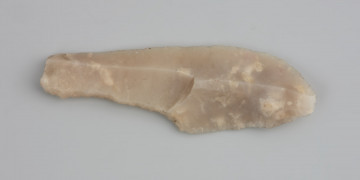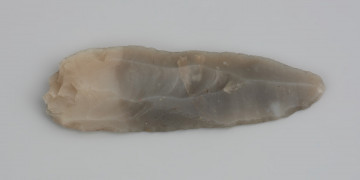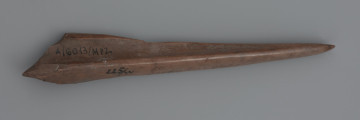
Single-jagged edge
11900 p.n.e. — 11000 p.n.e.
National Museum in Szczecin
Part of the collection: Stone Age
Dating to the Late Palaeolithic period, this end scraper was discovered, along with a collection of 44 objects of the Federmesser culture, by the amateur archaeologist H. Schumann from Löcknitz sometime before 1910, at a site called Streitkamp, near the present-day village of Wołczkowo, located in the Police district. After Schumann's death, the entire collection was donated to the Szczecin collectors' association "Gesellschaft für Pommersche Geschichte und Altertumskunde". The exact location of the discovery site remains unknown, as Schumann's original catalogue has been lost, and a copy has never been made. The underside of the artifact shows breakages and a so-called utilitarian retouch, which was the result of some form of binding made of bone, antler, or wood. The working edge shows no signs of use, suggesting that the tool was originally longer and was abandoned shortly after repair. End scrapers were used mainly for working leather and other organic materials. Often repaired, most were discarded when severely abraded, so the shape of the pieces found by archaeologists may strongly deviate from the original.The end scraper belongs to an exciting category of artefacts from Wołczków found in a context indicative of the Federmesser culture but technologically and typologically close to the older tradition of the Hamburg culture. Unlike the typical end scrapers of the Federmesser culture, the end scraper was made on a blade rather than a splinter, and its sides have been entirely retouched, which brings it closer to the Hamburg category. On the other hand, typical Hamburg end scrapers are significantly larger than the presented object. The fact that such forms exist with features characteristic of different cultures indicates that little is known about cultural contacts in the Late Palaeolithic. Michał Adamczyk
Author / creator
Object type
scapers (flint tool)
Technique
hard-hammer knapping
Material
chalk flint
Origin / acquisition method
acquisition
Creation time / dating
Creation / finding place
Owner
Muzeum Narodowe w Szczecinie
Identification number
Location / status

11900 p.n.e. — 11000 p.n.e.
National Museum in Szczecin

11900 p.n.e. — 11000 p.n.e.
National Museum in Szczecin

9600 p.n.e. — 4100 p.n.e.
National Museum in Szczecin
DISCOVER this TOPIC
Castle Museum in Łańcut
DISCOVER this PATH
Educational path